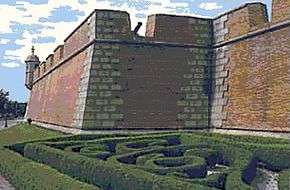Fort Conde
| Fort Condé | |
|---|---|
| Mobile, Alabama | |
|
Fort Conde in Mobile, Alabama is a 4/5 scale replica of part of the dismantled French, Spanish & British fort. | |
| Coordinates | 30°41′20″N 88°02′23″W / 30.68877°N 88.03980°WCoordinates: 30°41′20″N 88°02′23″W / 30.68877°N 88.03980°W |
| Type | Fort |
| Site information | |
| Controlled by | New France; Great Britain; Spain; United States |
| Site history | |
| Built | 1723 |
| In use | 1723-1820 |
Fort Conde, located in Mobile, Alabama, United States is a reconstruction, at 4/5 scale, as a third of the original 1720s French Fort Condé at the site. The original fort was also known as Fort Carlota under Spanish rule, and also Fort Charlotte under British and American rule.[1]
The current Fort Conde, spanning almost 1/3 of the original fort, was recreated at 4/5-scale on the site.[1] The new Fort Conde was opened on July 4, 1976, as part of Mobile's celebration of the United States bicentennial. The fort is located at 150 South Royal Street.
History
Mobile was originally founded by Jean-Baptiste Le Moyne de Bienville in 1702 as Fort Louis de la Mobile at 27-Mile Bluff up river (27 miles [43 km] from the mouth).[1][2] After the Mobile River flooded and damaged the fort, Mobile was relocated in 1711 to the current site. A temporary wooden stockade fort was constructed, also named Fort Louis after the old fort up river.[1] In 1723, construction of a new brick fort with a stone foundation began, renamed later as Fort Condé in honor of Louis Henri de Bourbon, duc de Bourbon and prince de Condé.
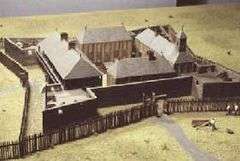
Fort Condé guarded Mobile and its citizens for almost 100 years, from 1723-1820.[1] The fort had been built by the French to defend against British or Spanish attack on the strategic location of Mobile and its Bay as a port to the Gulf of Mexico, on the easternmost part of the French Louisiana colony. The strategic importance of Mobile and Fort Condé was significant: the fort protected access into the strategic region between the Mississippi River and the Atlantic colonies along the Alabama River and Tombigbee River.[1]
Fort Condé and its surrounding buildings covered about 11 acres (45,000 m2) of land. It was constructed of local brick and stone, with earthen dirt walls, plus cedar wood.[1] A crew of 20 black slaves and 5 white workmen performed original work on the fort. If the fort had been reconstructed full-size, it would cover large sections of Royal Street, Government Boulevard, Church, St. Emanuel, and Theatre Streets in downtown Mobile.[1] The Fort Conde Village neighborhood, which now includes the Conde-Charlotte House historical museum, was constructed in 1822-1830s within the southern bastians of the original fort.
During 1763 to 1780, England was in possession of the region, and Fort Condé was renamed Fort Charlotte in honor of King George III’s wife.[1] From 1780 to 1813, Spain ruled the region, and the fort was renamed Fort Carlota. In 1813, Mobile was occupied by United States troops, and the fort was renamed again as Fort Charlotte.[1]
In 1820, the U.S. Congress authorized sale and removal of the fort because it was no longer needed for defense.[1] Later, city funds paid for the demolition to allow new streets built eastward towards the river and southward. By late 1823, most of the above-ground traces of Mobile’s fort were gone, leaving only underground structures.[1]
Original fort design
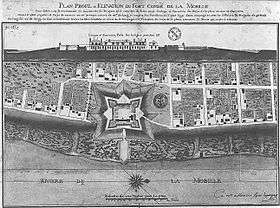
The original Fort Condé, from 1723, was shaped in the form of a seven-pointed star, with guard towers raised at the points (see map image) with significant surrounding earth works. In design, it is similar to Spanish fort Castillo de San Marcos in St. Augustine, Florida.
The settlement of Mobile (French "Mobille")[3] was aligned parallel to the Mobile River, rather than north/south, so that the fort faced somewhat northeast along an elevated bluff that was lined by "Royal Street" overlooking the marshland sloping down below.[3][4] (Even in contemporary Mobile, Royal Street is at higher elevation, with the newer streets of Water Street and Commerce Street [not on 1725 map] further down the slopes towards the Mobile River).
Some buildings within the fort compound had the French Mansard roof style, with dormer windows extending from each roof (see enlarged building images below, or building profiles at top of 1725 map).[3]
The tall chimneys at the ends of the buildings, shown in the map profile, were not used on the reconstructed Fort Condé. Also, the lengths of buildings were longer in the original fort, than represented in the 4/5 scale replica fort. The Mobile River is illustrated on the 1725 map with label "Riviere de la Mobille" as also using spelling "Mobille".
The map was drawn by Adrien de Pauger in 1725. After Jean-Baptiste Le Moyne de Bienville moved Mobile downriver in May 1711 (following the death of his brother Pierre Le Moyne d'Iberville in 1706), he planned the next capital city (after 1718) to be on the Mississippi River, in similar fashion to being on the Mobile River, and so Adrien de Pauger also designed the Vieux Carré in New Orleans, Louisiana, which was built from 1719-1722. The ships of the original French settlers, sailing to Old Biloxi in 1699, and later transfers, were staged through Dauphin Island (south of Mobile Bay, which was not dredged for larger ships until many years later).
Gallery
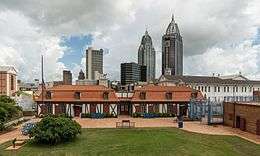 Interior of Fort Condé, with downtown Mobile in background; note French Mansard roofs. |
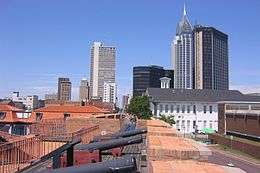 Cannon along the Royal Street battlements, facing right, out to the Mobile River. | |
 A corner bastion sentry box, topped with fleur de lis. |
.svg.png) French coat of arms, with 3 fleur de lis. |
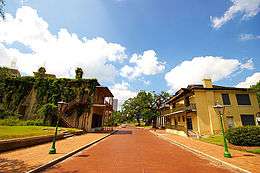 Fort Conde Village to the south of the fort. |
Notes
- 1 2 3 4 5 6 7 8 9 10 11 12 MoM-Other "Other Locations: Historic Fort Conde" (history), Museum of Mobile, Mobile, Alabama, 2006.
- ↑ "Mobile". Encyclopædia Britannica Online, 2007.
- 1 2 3 "Map: Plan Profile & Elevation of Fort Conde at Mobile" (map labeled in French, showing area of "Mobille" with top of map pointed WSW, rather than north). 2007. See: File:Mobile1725.jpg.
- ↑ Univ. of South Alabama Archives - markers item "16" (describing historical markers), 2006, Quote: "There were no streets between Royal and the river, only marshland" (in 1725); also shows map labeled "Mobille".
References
- Museum of Mobile, "Other Locations: Historic Fort Conde" (history), Mobile, Alabama, 2006, webpage: MoM-Other.
